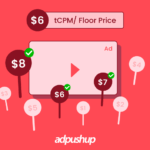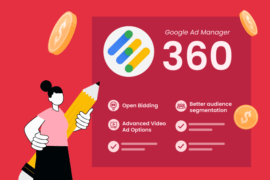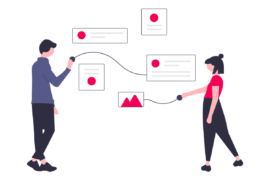Discover 7 quick facts about Exchange Bidding in Dynamic Allocation (EBDA), the programmatic advertising method that maximizes revenue by allowing ad exchanges to compete in real-time auctions.
Also commonly known as open bidding, exchange bidding is a dynamic allocation, which is an auction conducted by Google where the ad exchanges and SSPs (Supply Side Platforms) bid on the publisher’s ad inventory.
A study by OpenX showed there was a 48% average increase in the yield of publishers using Exchange Bidding. This study calculated its result basis the revenue generated by publishers in a span of 12 months.
Exchange bidding service has been available for DFP publishers since April 2018. However, there are still some publishers who feel delusional about exchange bidding. Here’re 5 things about Google exchange bidding that will give you clarity.
#1 What is Google Exchange Bidding?
The Google exchange bidding (now Open Bidding) process uses a server-to-server connection to communicate and exchange ad placement information. This is a server-side process where exchange networks and SSPs bid on the inventory in a unified auction.
Exchange bidding is often stated as Google header bidding and is also known as EBDA (Exchange Bidding in Dynamic Allocation). Google has partnered with multiple exchanges to make the services more accessible for publishers via Doubleclick. To understand how Google exchange bidding works, let’s start by understanding why we need it in the first place.
According to Google, exchange bidding is designed to reduce complexity without affecting the user experience. The complexity, mentioned by Google, is in reference to the header bidding complexity.
Since the announcement of EBDA, it has been greatly compared with header bidding because these methods efficiently optimize unsold inventory. We will get to the difference between these two later. Let’s understand how it works first.
#2 How Does Exchange Bidding (EBDA)Work?
Take a look at this image explaining the process:
- As soon as a visitor opens a webpage, the ad request is triggered. This request is taken to Ad Manager and from here, the Ad Manager takes charge.
- Ad Manager runs an auction to find the best bid for the available inventory.
- The ad manager looks for best-fit ads (shape, size, format, and traffic) for the available ad space and places them in a line.
- The requests are then sent to all the lined items and their yield partners to place their bids.
- Yield partners then submit their bids and the highest and most eligible bid is returned to the Ad Manager.
- A winner is selected and the Ad Manager completes this unified auction.
- Finally, Ad Manager returns the request to the page and the winner’s ad is displayed on the publisher’s ad space.
As you can see, the system is allocating ads dynamically in real time. Also, the entire process is handled by the Ad Manager in a unified auction which reduces the time taken to complete an entire auction.
#3 Getting Started with EBDA
In order to get started with EBDA, a publisher needs to check whether his/her network is compliant with exchange bidding or not.
If your ad network is one of Google’s public exchange partners, you can get started with EBDA instantly. Alternatively, you’ll need to contact Google.
Moreover, you need to have a Google Ad Manager account to enable exchange bidding. After you’re done with account creation, you need to create a company for exchange partners to place a bid on. Once the bidding is started, you can keep an eye on yield and manage it.
#4. What’s the Difference Between EBDA and Header Bidding?
In theory, both header bidding and EBDA are designed to put ads in front of the right audience to optimize the publisher’s inventory.
Header bidding was introduced to resolve the problems caused by the waterfall setup. In the waterfall process, a lot of unsold inventory was being left behind. This is when header bidding came to the rescue.
Using header bidding, a publisher gets to open his inventory to several demand partners before taking it to the ad server. And as expected, a publisher is able to increase ad revenue owing to this process.
Header Bidding sounds good. So why do we need EBDA?
Yes, header bidding is a good enough method to deal with unsold inventory. But it has some disadvantages as well. Header bidding is a complex process that requires high-level technical knowledge. Also, header bidding works on the client side.
This means when a visitor launches a web page, a bunch of browser requests are followed in order to show ads, directly resulting in an increase in page load time. An increase in page latency has put off many publishers from choosing header bidding.
How Does EBDA Help?
Unlike header bidding, EBDA is a unified process that minimizes complexity. Also, instead of running on the visitor’s browser, exchange bidding runs on the server side reducing the complexity and page latency for publishers.
However, It is not perfect either. It’s not as transparent as it was expected because it doesn’t offer full visibility of the auction process. On the contrary, header bidding is a more transparent process than Google exchange bidding.
#5. Any Alternative to Header Bidding and Exchange Bidding?
As you have seen, header bidding and EBDA have their advantages and disadvantages. So, publishers usually ask, “Is there any method that gives us all the advantages without having to face the disadvantages?”
The answer is Server-To-Server Header Bidding.
S2S header bidding is more of an improvement to header bidding. In S2S bidding, by taking the bidding process from the client side to the server side, a lot of issues were resolved. Page latency has to be one of the most important issues resolved by S2S header bidding.
Understand it this way, S2S header bidding is an improvement of header bidding. Then Google adopted the improvement and provided Google Exchange Bidding.
The only problem with using the server-to-server header bidding is, that it lacks in matching the right advertiser for the available publisher’s inventory. However, Google exchange bidding is one of the fairer auctions giving an equal chance to Google and AdX to bid on an inventory.
#6 What is the Difference between EBDA and Adsense?
One of the biggest differences between the two is that the Exchange bidding is only limited to the Google Ad Manager 360. On the other hand, Google Adsense is accessible to all publishers irrespective of their monthly traffic.
Next, when it comes to the auction, in the exchange bidding, demand partners are invited by the Google Ad Managers, however, that is not the case with Google Adsense. Adsnese allows the buyers or advertisers to be a part of the auction, depending on the target audience of the publisher.
Publishers are in a more advantageous position when it comes to exchange bidding. With open bidding, or exchange bidding, publishers get a higher CPM (Cost Per Mile), and more unified auctions compared to Google Adsense. Here’s what Unified Auctions include:
- Supply-Side Platforms
- Ad Networks
- Multiple Exchanges
#7 Limitations of EBDA
With so many benefits it holds, it comes with some limitations as well and reporting is one of them. There is the least amount of transparency offered by Google Ad Manager end.
In the current landscape, publishers have access to various metrics and insights on the dashboard. These include valuable information such as impressions, bid requests, and total revenue. However, one crucial aspect remains elusive: the precise individual bids placed for the ad space. This particular metric becomes visible and accessible when operating with Header Bidding.
Conclusion
There is no perfect bidding method without any drawbacks. In Google exchange bidding’s defense, it’s a new technology making its way into the Ad tech industry. For publishers depending on Google, EBDA can be a great method to monetize their inventory.
Working on the server side and removing a few seconds from load time might seem like a small thing. But it can work miraculously when comes to revenue generation.
Frequently Asked Questions
In simple words, it refers to a programmatic advertising method where multiple ad exchanges compete simultaneously in real-time to fill an ad impression, maximizing revenue for publishers.
The main difference between an ad exchange and open bidding lies in the level of transparency and control. An ad exchange is a platform that facilitates the buying and selling of ad inventory, where publishers and advertisers can connect.

Deepak has a keen eye for detail and a deep understanding of the ad tech landscape. Whether it’s through in-depth articles, thought-provoking insights, or compelling storytelling, he’s dedicated to helping people navigate the complex world of ad tech with the simplicity of his words.







